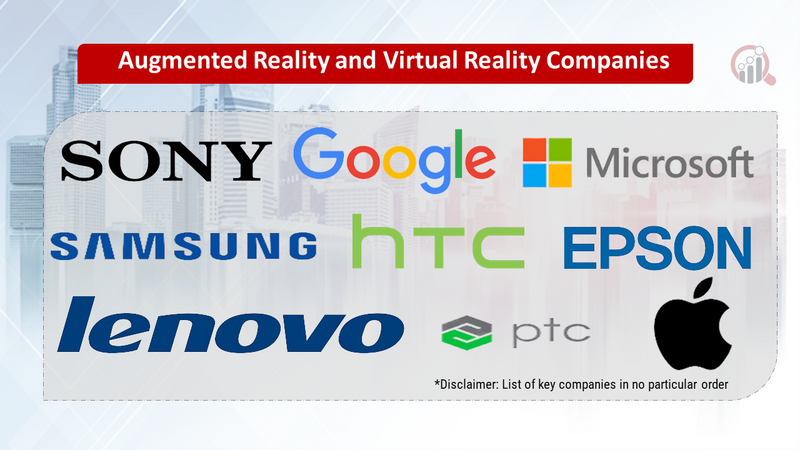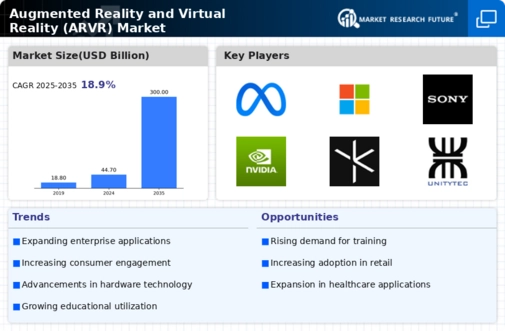Top Industry Leaders in the Augmented Reality Virtual Reality Market

Augmented Reality and Virtual Reality Market: Dive into the Latest News and Updates
The augmented reality (AR) and virtual reality (VR) market is experiencing exponential growth, propelled by advancements in technology, rising demand for immersive experiences, and increasing integration with various industries. These technologies create new ways to interact with information, environments, and objects, blurring the lines between the physical and digital worlds.
Some of Augmented Reality and Virtual Reality Companies Listed Below:
- Google (US)
- Sony Corporation (Japan)
- Apple Inc. (US)
- Samsung (South Korea)
- Microsoft (US)
- HTC Corporation (Taiwan)
- Oculus (US)
- PTC (US)
- Seiko Epson Corporation (Japan)
- Lenovo (China)
- Wikitude (Austria)
- Blippar Group Limited (UK)
- MAXST CO., Ltd. (South Korea)
- EON Reality (US)
- Uil VR Solutions BV (US)
- CyberGlove Systems Inc. (US)
- Nintendo (Japan)
Strategies Driving Market Share Growth:
-
Product Diversification: Companies are expanding their offerings with diverse AR and VR solutions catering to different needs and budgets, from affordable VR headsets to advanced AR glasses. -
Content Development and Partnerships: Creating compelling AR and VR content through partnerships with developers and studios is crucial for user engagement and market adoption. -
Hardware and Software Advancements: Continuous advancements in hardware (displays, processors, haptics) and software (rendering engines, spatial tracking) enhance user experience and realism. -
Industry-Specific Applications: Tailoring AR and VR solutions to specific industry needs, like remote assistance, training simulations, or product visualization, fosters broader adoption and market growth.
Factors Influencing Market Share Analysis:
-
Technology Maturity and Accessibility: The pace of technological advancements, cost of devices, and ease of development tools impact market adoption and influence player success. -
Target Audience and Use Cases: Understanding the specific needs and preferences of different user groups, like gamers, professionals, or consumers, is crucial for tailoring solutions and achieving market success. -
Content Availability and Quality: The quantity and quality of available AR and VR content directly impact user engagement and market growth. -
Regulatory Landscape and Data Privacy: Evolving regulations on data privacy and safety standards need to be carefully navigated by companies to gain user trust and market acceptance.
Emerging Companies and Innovation Trends:
-
Focus on Accessibility and Affordability: Startups are developing cheaper, more accessible AR and VR solutions to broaden user base and market penetration. -
Focus on Productivity and Enterprise Applications: Increasing focus on AR solutions for enterprise applications, like remote collaboration, training, and maintenance, expands market potential beyond gaming and entertainment. -
Integration with AI and Machine Learning: Integrating AI and machine learning into AR and VR enables features like real-time object recognition, personalized experiences, and enhanced interactivity.
Current Investment Trends:
-
Venture Capital Funding: Innovative startups developing cutting-edge AR and VR technologies and applications are attracting significant venture capital funding, fueling market growth and innovation. -
Strategic Partnerships and Acquisitions: Established players are forming strategic partnerships and acquiring promising startups to access new technologies, content, and markets. -
Research and Development: Leading companies are investing heavily in research and development to stay ahead of the curve with advanced hardware, software, and content creation tools.
Latest Company Updates:
February 10, 2024:
- Apple's Vision Pro AR headset launch: Marking a significant entry into the consumer AR market with advanced features and capabilities.
- Challenges regarding price point, content availability, and long-term user adoption still present.
February 24, 2024:
- Growing emphasis on enterprise AR adoption: Training, remote collaboration, and design visualization applications driving business value.
- Need for interoperability standards and security protocols for seamless integration into existing enterprise workflows.
March 8, 2024:
- Meta and HTC announce new VR headsets: Focus on improved performance, comfort, and content libraries to boost VR user base.
- Battery life limitations and concerns about physical and mental health impacts of extended VR use remain.
March 22, 2024:
- Integration of AI and machine learning: Personalized AR/VR experiences, real-time object recognition, and enhanced content interaction.
- Ethical considerations regarding AI bias and data privacy in AR/VR applications need careful attention.
April 5, 2024:
- Focus on metaverse development: Building persistent, immersive virtual worlds for work, socializing, and entertainment.
- Challenges concerning interoperability, governance, and user safety in the metaverse require collaborative solutions.

